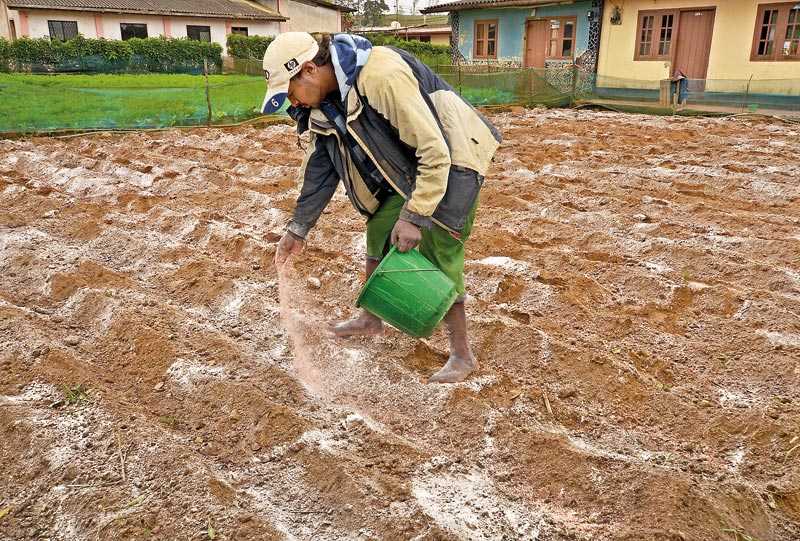Monday Feb 24, 2025
Monday Feb 24, 2025
Friday, 30 April 2021 01:21 - - {{hitsCtrl.values.hits}}

A potato farmer spreading fertiliser. A drastic policy of halting the use of chemical fertilisers completely will cause massive damage to the agriculture of Sri Lanka – Pic by Shehan Gunasekara
 The type of disease afflicting Sri Lanka is not one that will, over time, cure itself, but one that can only be healed with a complex surgery.
The type of disease afflicting Sri Lanka is not one that will, over time, cure itself, but one that can only be healed with a complex surgery.
The functioning of the Legislature, the Executive and the Judiciary is in a state of total collapse while that of all other institutions is also in a similar state. There is no integration and cohesion in the social system and it is in a fragmented state. The economy is also on the verge of bankruptcy.
When the State finds itself in such a dire situation, what usually should have happened was to venture to reach consensus with all political parties and direct the country towards a structural reform program that would help recreate the State and the socio-political system. But no such dialogue has yet begun.
The COVID pandemic is also acting as a crucial factor hampering the country’s ability to overcome the crisis. Despite the major drawbacks in the policies adopted in controlling the spread of the pandemic, Sri Lanka was lucky to avoid its serious damage and ramifications, thanks to the BCG vaccine administered to a significant portion of the entire population.
Of the countries that have administered the BCG vaccine, perhaps Sri Lanka is the only country that has achieved almost 100% target in administering the BCG vaccine to its population. This is a good health practice being maintained since 1949, and if it was not for this practice, the price Sri Lanka has to pay for Corona could have been extremely huge.
The President’s dream
The decision taken by the President to halt the importation of agrochemical fertiliser and pesticide completely could have a devastating effect on rural and commercial agriculture in general. Its adverse effect on the rural peasantry and on plantation workers in the estate sector also could be destructive. It will inevitably serve as a factor that would intensify the country’s economic downturn as well.
The President states that instead of promoting the use of chemical fertiliser, he will introduce a system for producing organic fertiliser by fertiliser companies and provide them to farmers on a subsidised basis, and if there is a decrease in yield, a scheme will be introduced to compensate for that.
The way the President thinks about pesticide and chemical fertiliser and the prevailing popular views in the country in regard to them cannot be considered correct. It is true that the application of chemical fertiliser and pesticide has damaged biodiversity and caused health problems due to infiltration of chemicals to water and food. But despite such adverse effects, it would not be practically possible to completely eliminate the use of chemical fertiliser and pesticide and fill the vacuum created with organic fertiliser and application of conventional pesticide methods.
The need for chemical fertiliser
A land of virgin soil can be cultivated without fertiliser. In the past when there was plenty of land, the problems relating to the depletion of the fertility of soil following a land being cultivated for some time, were solved by abandoning the plot of land already cultivated and shifting the cultivation into a new plot of land.
However, with the rapid growth of population, it became necessary to deviate from the old tradition of shifting cultivation and move into a new tradition of cultivating the same land continuously. This, in the course of time, resulted in the depletion of the richness of soil and the yield, necessitating finding alternative solutions to overcome the problems. The advent of the Green Revolution was the outcome of this process. Chemical fertiliser, pesticide, and improved seed varieties can be considered as the result of the Green Revolution.
By the time Sri Lanka gained independence, paddy cultivation, the staple food of the people, was carried out without using any chemical fertiliser or pesticide. The decayed bones of cattle were the only fertiliser rarely used if at all fertiliser was used. The yield per acre of paddy land remained at 35 bushels or 717 kg. At that time, Sri Lanka produced about 40% of the country’s rice requirement. The importation of rice and wheat flour occupied 30% of import expenditure.
Growth of paddy cultivation
To bring about a positive change in this situation, the Department of Agriculture of Sri Lanka applied the methods introduced by the Green Revolution for local agriculture. Accordingly, disease-resistant, high-yielding varieties of paddy were introduced instead of the traditional varieties. The use of chemical fertiliser and pesticide was encouraged.
The results were revolutionary and unprecedented. By 1952, only 40% of the rice needed for a population of eight million could be produced. Sixty years later, it was possible to produce 4.3 million metric tons of rice, enough for a population of 20 million. During this period, it has been possible to increase the yield per acre by 712%.
Undoubtedly, there were harmful side effects accompanied by this progress, but most of them could be considered due to issues caused by serious mismanagement of the subject rather than a fault in chemical fertiliser or pesticide themselves. If Sri Lanka had followed the good practices adopted by some countries in the field of agrochemicals, it would have been possible to minimise the damage caused by side effects.
The reality of organic fertiliser
We must not forget that everything around us does consist of chemicals. Even organic fertiliser consists of chemicals. Increased concern about the entry of various heavy metals into the human food chain has occurred in recent years, and all aspects of agricultural production and food processing are being examined.
Organic fertiliser also contains heavy metal contaminants. Cadmium (Cd) is the heavy metal of most interest because potentially it may be harmful to human health. Animal manures and sewage biosolids applied to agriculture also contain Cadmium and other heavy metals though the concentrations are low and no significant buildup of heavy metals would be expected to occur from moderate manure application rates on agricultural lands. In this backdrop organic fertiliser cannot be considered as a good alternative to chemical fertiliser.
Furthermore, organic fertiliser is not as effective as chemical fertilisers and the quantum of organic fertiliser required to compensate for one kg of chemical fertiliser is as high as 50 kg. Although there is a big voice for organic farming, it still operates in about 1.5% of the agricultural land cultivated in the world.
The import of chemical fertiliser by Sri Lanka amounts to 1,260,053 metric tons per year. Of this 383,000 metric tons were for paddy cultivation. The remaining 877,053 metric tons were for other crops. If enough organic manure were to be produced to compensate for this quantity, it would amount to a staggering quantity of 63,000,000 metric tons per year. Attempts to produce such a large quantity of organic manure will inevitably lead to creating an unbearable and uninhabitable stench in the country apart from causing a huge mosquito problem as well.
The big explosions caused recently in Kolonnawa and Meethotamulla due to methane produced in garbage dumps could occur in the huge organic fertiliser dumps also. Inevitably, a drastic policy of halting the use of chemical fertilisers completely will cause massive damage to the agriculture of Sri Lanka.
Discover Kapruka, the leading online shopping platform in Sri Lanka, where you can conveniently send Gifts and Flowers to your loved ones for any event including Valentine ’s Day. Explore a wide range of popular Shopping Categories on Kapruka, including Toys, Groceries, Electronics, Birthday Cakes, Fruits, Chocolates, Flower Bouquets, Clothing, Watches, Lingerie, Gift Sets and Jewellery. Also if you’re interested in selling with Kapruka, Partner Central by Kapruka is the best solution to start with. Moreover, through Kapruka Global Shop, you can also enjoy the convenience of purchasing products from renowned platforms like Amazon and eBay and have them delivered to Sri Lanka.
Discover Kapruka, the leading online shopping platform in Sri Lanka, where you can conveniently send Gifts and Flowers to your loved ones for any event including Valentine ’s Day. Explore a wide range of popular Shopping Categories on Kapruka, including Toys, Groceries, Electronics, Birthday Cakes, Fruits, Chocolates, Flower Bouquets, Clothing, Watches, Lingerie, Gift Sets and Jewellery. Also if you’re interested in selling with Kapruka, Partner Central by Kapruka is the best solution to start with. Moreover, through Kapruka Global Shop, you can also enjoy the convenience of purchasing products from renowned platforms like Amazon and eBay and have them delivered to Sri Lanka.